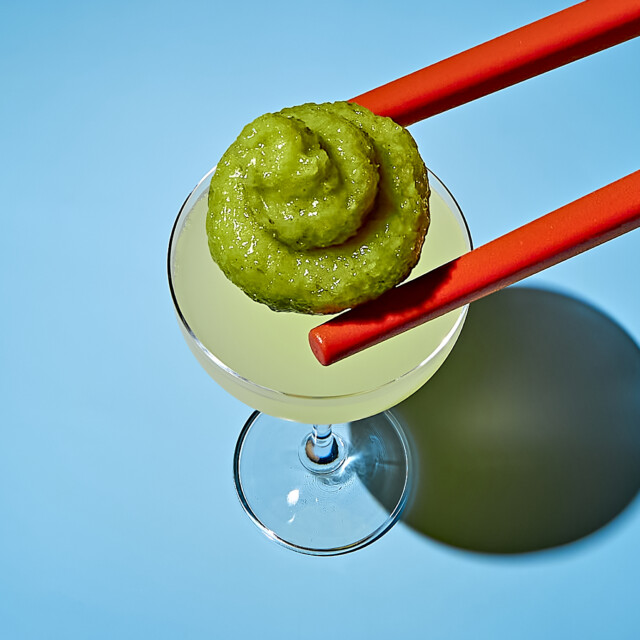We hate to break it to you, but that green mush you’re squeezing from a packet onto your spicy tuna roll isn’t actual wasabi. An astounding percentage of “wasabi” served with sushi outside of Japan — between 95 and 99 percent of it — is actually a mix of horseradish, mustard, and green food coloring. There’s a reason we still add the stuff to our choice slices of sashimi, though: Horseradish, just like wasabi, provides a sinus-clearing spice that fades quickly, balancing the delicate taste of the fish without overpowering it. But why not just use proper wasabi?
Well, it’s notoriously difficult to grow, making it a scarce resource that is also pretty damn expensive. The vast majority of the finicky root is cultivated in Japan, hence its name, Wasabia japonica. However, in recent years, Iceland has emerged as an unexpected second home for the plant, and what’s being deemed Nordic wasabi is quickly becoming a prized ingredient in the country’s gastronomic landscape. Now, you’d be hard-pressed to take a seat at one of Reykjavik’s many acclaimed fine-dining restaurants and not see the stuff shaved atop a dish or drizzled on in oil form. Forward-thinking bartenders are also embracing the punchy, vegetal spice that Nordic wasabi brings, offering a fresh take on the fiery root in cocktail format.
From the Soil to the Greenhouse
Traditionally found along Japan’s cool, rushing rivers, the wasabi plant requires specific conditions: clean and cold water, high humidity, and shade. Iceland, with its dramatic and untamed landscapes, might seem an unlikely candidate for cultivating a plant so high-maintenance. But thanks to the island’s abundant geothermal energy, Iceland has actually developed advanced methods for greenhouse farming, creating the perfect controlled environment to nurture the delicate wasabi plant.
“Taste and application [in Japanese and Icelandic wasabi] are similar. However, our Nordic wasabi grows in our greenhouses in Iceland,” says Tanja Stefanía of Nordic Wasabi, the country’s first grower and purveyor of hydroponically grown wasabi, which now supplies many of the capital city’s restaurants and bars with the spicy root. “Our greenhouses are among the most technologically advanced in Europe. Advanced computer systems control heat, brightness, humidity, and are in charge of watering our plants with specific nutrients, with times and quantities based on environmental data.”
While most of us are used to that sharp, sinus-tingling sensation we associate with mainstream wasabi paste, authentic Japanese wasabi offers a more nuanced experience — less of an aggressive burn and more of a complex, herbal warmth. Nordic wasabi shares these same traits, but with a distinctive twist: This hydroponically grown strain tastes slightly more earthy, with a hint of sweetness that sets it apart from its Japanese counterpart. It’s less intense on the palate but just as flavorful, making it ideal for use in delicate dishes and drinks where balance is key. This difference in flavor has made Nordic wasabi particularly attractive to mixologists and experimental chefs across Reykjavik, who have taken to turning the root into a concentrated oil that packs a punch.
Drinks With Heat
In recent years, Reykjavik’s small but mighty cocktail scene has seen a come-up, spurred in part by innovative bartenders experimenting with distinctly Icelandic ingredients like Brennivin (the country’s national spirit, also known as the Black Death) as well as seaweed, skyr (yogurt), and birch syrup. Nordic wasabi has joined them, with local mixologists finding ways to incorporate its distinct sharpness and earthy undertones into both alcoholic and booze-free beverages. Its subtler heat and crisp finish lend themselves perfectly to cocktails, adding depth without overwhelming other ingredients.
The first establishment in the city to infuse a drink with Nordic wasabi was Fiskmarkaðurinn, a longstanding seafood restaurant, where the Wasabi Mule was introduced five years ago and can still be found on the menu. In it, wasabi adds an unexpected punch to the classic combination of mint and lime to create a balanced flavor profile that’s equal-parts fresh and fiery. At Askur Taproom, a brewery that features both local and international craft beers, you’ll find a wasabi-infused double IPA made. The ingredient has also found its way into a Margarita at local Japanese spot Sushi Social, made with reposado, mezcal, jalapeno, Icelandic wasabi, and a gochujang and sesame salt rim.
“Nordic wasabi brings a new, fresh flavor to cocktails that has not been previously explored while also elevating the experience by using an expensive luxury ingredient,” says Baldur Guðmundsson Hraunfjörð, bartender at Reykjavik’s Bodega Bar. There, he’s paired wasabi paste with sesame oil, green italian bitters, and gin “to make an interesting concoction that challenges the norm of cocktail flavors.”
“Keeping in mind the time that goes into growing each plant, it would be downright disrespectful not to use the leaves, for instance, which I find equally impressive in flavor.”
At Amma Don, a subterranean cocktail bar adjoined to acclaimed fine dining restaurant Óx, wasabi has been featured in the bar program several times.
“We had a wasabi leaf Martini, which was tasty,” says bar manager David Hood. Both Amma Don and Óx are known for their emphasis on Icelandic ingredients, and Hood emphasizes that Nordic wasabi is one that they always find new, more sustainable ways to tinker with.
“Utilizing each component of the plant is vital, as this produce is quite expensive,” he says. “Keeping in mind the time that goes into growing each plant, it would be downright disrespectful not to use the leaves, for instance, which I find equally impressive in flavor.”
As Hood says, the appeal of Nordic wasabi lies in its adaptability. His team’s bartenders have used various parts of the plant in innovative ways: the leaves are juiced, the stem transformed into a paste.
And the bar’s latest addition — a pure wasabi powder — opens even more possibilities for blending into cocktails. Hood tells us that while he’s started to see Nordic wasabi show up in cocktails, “I’d love to see more of it.”
